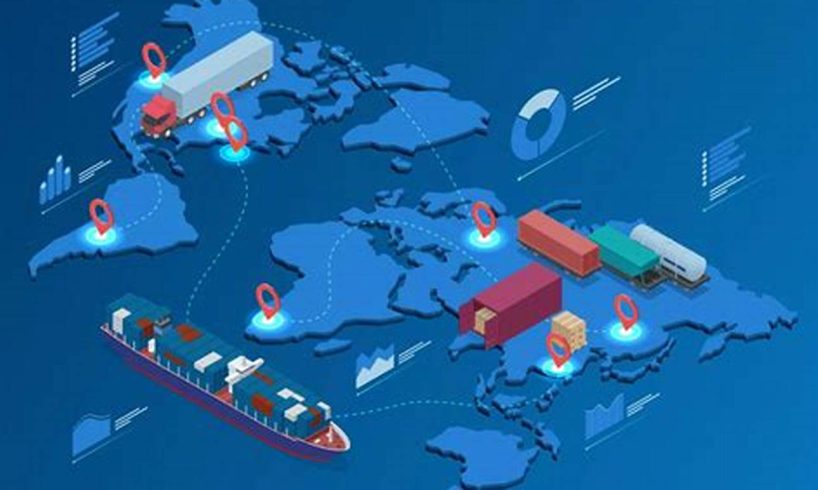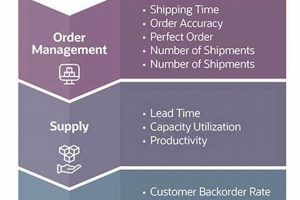
In the realm of logistics, tracking systems emerged as a transformative force in the 2000s, revolutionizing the way businesses monitored and managed their supply chains. These systems leveraged advancements in technology, such as GPS, RFID, and wireless networks, to provide real-time visibility into the movement of goods and assets.
The benefits of tracking systems were far-reaching. They enabled businesses to optimize their transportation routes, reduce inventory levels, enhance customer service, and gain a competitive edge. By providing real-time data on the location and status of shipments, tracking systems empowered logistics professionals to make informed decisions and respond swiftly to disruptions or delays.
The adoption of tracking systems in the 2000s marked a significant milestone in the evolution of logistics. It ushered in an era of greater efficiency, transparency, and control, paving the way for the sophisticated and interconnected supply chains we rely on today.
1. GPS
Global Positioning System (GPS) emerged as a key technology in tracking systems during the 2000s, revolutionizing the way logistics companies tracked the movement of goods and assets. GPS provided precise location data, enabling real-time visibility and enhanced decision-making.
- Satellite Navigation
GPS satellites transmitted signals that receivers in vehicles or mobile devices could use to calculate their location. This accurate positioning enabled logistics companies to track the exact location of shipments and assets, improving visibility and control. - Real-Time Tracking
GPS tracking systems provided real-time data on the location and status of shipments. This allowed logistics professionals to monitor the progress of deliveries, identify potential delays, and respond swiftly to disruptions. - Route Optimization
By leveraging GPS data, logistics companies could optimize transportation routes, taking into account real-time traffic conditions and vehicle locations. This resulted in reduced travel times, fuel savings, and improved delivery efficiency. - Enhanced Security
GPS tracking also enhanced the security of shipments by providing real-time visibility into their location. In the event of theft or unauthorized movement, logistics companies could quickly track and recover assets, reducing losses and protecting valuable cargo.
Overall, GPS played a crucial role in the development of tracking systems in 2000s logistics, providing accurate and real-time location data that transformed the way businesses managed their supply chains.
2. RFID
Radio Frequency Identification (RFID) emerged as a transformative technology in tracking systems during the 2000s, revolutionizing the way logistics companies tracked and managed their inventory and assets. RFID systems leveraged radio waves to automatically identify and track items, providing real-time visibility and enhanced efficiency throughout the supply chain.
RFID tags, attached to individual items or containers, emitted unique radio signals that RFID readers could detect and decode. This enabled logistics companies to track the movement of goods and assets throughout their facilities, warehouses, and transportation routes. RFID systems provided several key advantages:
- Real-Time Tracking
RFID systems provided real-time visibility into the location and status of items. This allowed logistics companies to track the progress of shipments, identify potential delays, and respond swiftly to disruptions. - Improved Inventory Management
RFID enabled more accurate and efficient inventory management. By tracking individual items, logistics companies could optimize stock levels, reduce shrinkage, and improve overall inventory control. - Enhanced Security
RFID systems enhanced the security of shipments by providing real-time visibility into their location. In the event of theft or unauthorized movement, logistics companies could quickly track and recover assets, reducing losses and protecting valuable cargo.
RFID played a crucial role in the development of tracking systems in 2000s logistics, providing real-time visibility and enhanced control over the movement of goods and assets. Its integration with other technologies, such as GPS and wireless networks, further transformed the logistics industry, leading to greater efficiency, productivity, and innovation.
3. Wireless Networks
Wireless networks played a pivotal role in revolutionizing tracking systems in 2000s logistics. The seamless transmission of data over wireless networks enabled real-time visibility and control over the movement of goods and assets, leading to significant advancements in the logistics industry.
- Data Transmission
Wireless networks provided a reliable and efficient means to transmit data between tracking devices and central systems. This enabled real-time updates on the location and status of shipments, empowering logistics professionals with up-to-date information for informed decision-making. - Remote Monitoring
Wireless networks allowed logistics companies to remotely monitor their assets and shipments in real-time. This enabled proactive management of potential delays or disruptions, minimizing downtime and ensuring the smooth flow of goods. - Scalability and Flexibility
Wireless networks offered scalability and flexibility to tracking systems, enabling logistics companies to expand their tracking capabilities as needed. This adaptability supported the growing demands of complex supply chains and the increasing volume of shipments. - Integration with Other Technologies
Wireless networks facilitated the integration of tracking systems with other technologies such as GPS and RFID. This convergence of technologies provided a comprehensive view of the supply chain, enhancing visibility, control, and efficiency.
The integration of wireless networks into tracking systems in 2000s logistics transformed the industry, enabling real-time visibility, remote monitoring, scalability, and seamless integration with other technologies. These advancements laid the foundation for the sophisticated and interconnected supply chains we rely on today.
4. Real-Time Data
In the realm of 2000s logistics, real-time data emerged as a cornerstone of tracking systems, revolutionizing the way businesses monitored and managed their supply chains. Real-time data provided a continuous stream of up-to-date information on the location, status, and condition of shipments, empowering logistics professionals with unprecedented visibility and control.
The importance of real-time data in tracking systems cannot be overstated. It enabled logistics companies to:
- Monitor progress and identify delays: Real-time data allowed logistics professionals to track the progress of shipments in real-time, identifying potential delays or disruptions early on. This enabled them to take proactive measures, such as rerouting shipments or adjusting delivery schedules, to minimize the impact on customers.
- Optimize inventory management: Real-time data provided insights into inventory levels, enabling logistics companies to optimize stock levels and reduce the risk of stockouts. By tracking inventory in real-time, businesses could ensure that the right products were available at the right time and place.
- Improve customer service: Real-time data empowered logistics companies to provide better customer service. By having access to up-to-date information on the status of shipments, customer service representatives could provide accurate and timely updates to customers, enhancing the overall customer experience.
The practical significance of understanding the connection between real-time data and tracking systems in 2000s logistics is immense. It transformed the way businesses managed their supply chains, leading to improved efficiency, reduced costs, and enhanced customer satisfaction. The insights gained from real-time data continue to shape the logistics industry today, enabling businesses to make data-driven decisions and optimize their operations.
5. Optimization
In the realm of 2000s logistics, tracking systems emerged as a powerful tool for optimization, enabling businesses to streamline their supply chains, reduce costs, and improve customer service. By leveraging real-time data on the location, status, and condition of shipments, logistics professionals gained unprecedented visibility and control over their operations, driving significant improvements in:
- Route planning and scheduling: Tracking systems provided real-time data on traffic conditions, vehicle locations, and delivery schedules, enabling logistics companies to optimize their routes and schedules for maximum efficiency. This resulted in reduced fuel consumption, lower transportation costs, and improved on-time delivery performance.
- Inventory management: Real-time inventory tracking allowed businesses to maintain optimal stock levels, reducing the risk of stockouts and overstocking. By tracking inventory levels across multiple locations and throughout the supply chain, logistics companies could ensure that the right products were available at the right time and place.
- Warehouse management: Tracking systems provided real-time visibility into warehouse operations, enabling logistics professionals to optimize space utilization, improve picking and packing processes, and reduce handling times. This resulted in increased warehouse efficiency, reduced labor costs, and faster order fulfillment.
- Customer service: Real-time tracking data empowered customer service representatives with up-to-date information on the status of shipments. This enabled them to provide accurate and timely updates to customers, proactively address potential issues, and enhance the overall customer experience.
The connection between optimization and tracking systems in 2000s logistics was profound. By leveraging real-time data and advanced algorithms, businesses gained the ability to make data-driven decisions, streamline their operations, and achieve significant improvements in efficiency, cost, and customer satisfaction. The insights gained from tracking systems continue to shape the logistics industry today, enabling businesses to optimize their supply chains and gain a competitive edge in the global marketplace.
6. Efficiency
In the realm of 2000s logistics, tracking systems emerged as a transformative force, revolutionizing the way businesses managed their supply chains and achieved new levels of efficiency. The connection between efficiency and tracking systems was profound, with tracking systems providing real-time data and insights that enabled logistics professionals to optimize their operations, reduce costs, and improve customer service.
The real-time visibility provided by tracking systems allowed logistics companies to identify and eliminate inefficiencies throughout their supply chains. By tracking the location, status, and condition of shipments, businesses could pinpoint bottlenecks, delays, and areas for improvement. This data-driven approach empowered logistics professionals to make informed decisions, such as adjusting routes, optimizing inventory levels, and improving warehouse operations.
One practical example of the efficiency gains achieved through tracking systems is the reduction in transportation costs. By optimizing routes and schedules, logistics companies could reduce fuel consumption and lower transportation costs. Additionally, real-time inventory tracking helped businesses minimize stockouts and overstocking, reducing inventory carrying costs and improving cash flow.
The efficiency improvements brought about by tracking systems in 2000s logistics had a ripple effect throughout the supply chain. Faster and more efficient delivery times led to improved customer satisfaction and increased sales. Reduced costs and improved inventory management contributed to increased profitability for businesses.
In summary, the connection between efficiency and tracking systems in 2000s logistics was a key driver of the industry’s transformation. By leveraging real-time data and advanced technologies, logistics companies gained unprecedented visibility and control over their operations, enabling them to streamline processes, reduce costs, and improve customer service. The insights gained from tracking systems continue to shape the logistics industry today, driving innovation and efficiency at every level of the supply chain.
7. Transparency
In the realm of 2000s logistics, tracking systems emerged as a powerful force for transparency, revolutionizing the way businesses monitored and managed their supply chains. The connection between transparency and tracking systems was profound, with tracking systems providing real-time visibility and data that enabled logistics professionals to gain unprecedented insights into their operations.
The real-time visibility provided by tracking systems allowed logistics companies to track the location, status, and condition of shipments throughout the supply chain. This transparency had a transformative impact on the industry, leading to several key benefits:
- Improved communication and collaboration: Tracking systems facilitated seamless communication and collaboration among different stakeholders in the supply chain, including suppliers, carriers, and customers. Real-time data sharing enabled all parties to have a clear understanding of the status of shipments, reducing the risk of misunderstandings and delays.
- Enhanced customer service: Transparency empowered logistics companies to provide better customer service. By having access to real-time information on the status of shipments, customer service representatives could provide accurate and timely updates to customers, proactively address potential issues, and improve the overall customer experience.
- Reduced risk and fraud: Tracking systems enhanced the security and accountability of the supply chain. Real-time visibility helped logistics companies identify and mitigate potential risks, such as theft, fraud, and counterfeiting. By tracking the movement of goods and assets, businesses could deter unauthorized access and ensure the integrity of their supply chains.
The practical significance of understanding the connection between transparency and tracking systems in 2000s logistics is immense. Transparency transformed the way businesses managed their supply chains, leading to improved communication, enhanced customer service, and reduced risk. The insights gained from tracking systems continue to shape the logistics industry today, enabling businesses to build more transparent, efficient, and resilient supply chains.
8. Control
In the realm of 2000s logistics, tracking systems emerged as a transformative force, revolutionizing the way businesses managed their supply chains and achieved new levels of control. The connection between control and tracking systems was profound, with tracking systems providing real-time data and insights that enabled logistics professionals to exercise unprecedented control over their operations.
The real-time visibility provided by tracking systems allowed logistics companies to monitor the location, status, and condition of shipments throughout the supply chain. This control had a transformative impact on the industry, leading to several key benefits:
- Improved decision-making: Tracking systems empowered logistics professionals with real-time data to make informed decisions. By having a clear understanding of the status of shipments, logistics companies could proactively address potential issues, adjust routes, and allocate resources more efficiently.
- Reduced risk and theft: Tracking systems enhanced the security and accountability of the supply chain. Real-time visibility helped logistics companies identify and mitigate potential risks, such as theft, fraud, and counterfeiting. By tracking the movement of goods and assets, businesses could deter unauthorized access and ensure the integrity of their supply chains.
- Enhanced customer service: Control over the supply chain enabled logistics companies to provide better customer service. By having access to real-time information on the status of shipments, customer service representatives could provide accurate and timely updates to customers, proactively address potential issues, and improve the overall customer experience.
The practical significance of understanding the connection between control and tracking systems in 2000s logistics is immense. Control transformed the way businesses managed their supply chains, leading to improved decision-making, reduced risk, and enhanced customer service. The insights gained from tracking systems continue to shape the logistics industry today, enabling businesses to build more controlled, efficient, and resilient supply chains.
9. Supply Chain
In the realm of logistics, a supply chain encompasses the interconnected processes involved in producing and delivering a product or service to the end consumer. Tracking systems emerged as a transformative force in 2000s logistics, enabling businesses to gain unprecedented visibility and control over their supply chains.
- Inventory Management:
Tracking systems provided real-time visibility into inventory levels, enabling businesses to optimize stock levels, reduce the risk of stockouts, and improve cash flow. By tracking inventory across multiple locations and throughout the supply chain, logistics professionals could ensure the right products were available at the right time and place. - Transportation and Logistics:
Tracking systems enabled logistics companies to track the location and status of shipments in real-time, allowing them to optimize routes, reduce transportation costs, and improve on-time delivery performance. Real-time data on traffic conditions, vehicle locations, and delivery schedules empowered logistics professionals to make informed decisions and adjust plans accordingly. - Warehouse Management:
Tracking systems provided real-time visibility into warehouse operations, enabling logistics professionals to optimize space utilization, improve picking and packing processes, and reduce handling times. This resulted in increased warehouse efficiency, reduced labor costs, and faster order fulfillment. - Customer Service:
Tracking systems empowered customer service representatives with up-to-date information on the status of shipments. This enabled them to provide accurate and timely updates to customers, proactively address potential issues, and enhance the overall customer experience.
The connection between supply chain and tracking systems in 2000s logistics was profound. Tracking systems provided the real-time data and insights that enabled logistics professionals to optimize their supply chains, reduce costs, improve customer service, and gain a competitive edge in the global marketplace. The insights gained from tracking systems continue to shape the logistics industry today, driving innovation and efficiency at every level of the supply chain.
Frequently Asked Questions on Tracking Systems in 2000s Logistics
This section addresses some of the most common questions and misconceptions surrounding tracking systems in 2000s logistics, providing clear and concise answers to enhance your understanding.
Question 1: What were the key technologies driving tracking systems in the 2000s?
The primary technologies shaping tracking systems in the 2000s included GPS (Global Positioning System), RFID (Radio Frequency Identification), and wireless networks. GPS provided precise location data, RFID enabled automatic identification and tracking of items, and wireless networks facilitated seamless data transmission.
Question 2: How did tracking systems improve inventory management?
Tracking systems revolutionized inventory management by providing real-time visibility into inventory levels and the movement of goods. This allowed businesses to optimize stock levels, reduce the risk of stockouts, and enhance overall inventory control.
Question 3: What impact did tracking systems have on transportation and logistics?
Tracking systems transformed transportation and logistics by enabling real-time tracking of shipments, optimization of routes, and reduction of transportation costs. Logistics companies could monitor the progress of deliveries, identify potential delays, and respond swiftly to disruptions, leading to improved on-time delivery performance.
Question 4: How did tracking systems enhance customer service?
Tracking systems empowered customer service representatives with up-to-date information on the status of shipments. This enabled them to provide accurate and timely updates to customers, proactively address potential issues, and enhance the overall customer experience, fostering trust and satisfaction.
Question 5: What are the key benefits of implementing tracking systems in logistics?
The key benefits of implementing tracking systems in logistics include improved efficiency, reduced costs, enhanced transparency, increased control, and improved customer service. Tracking systems provide real-time data and insights that empower logistics professionals to make informed decisions, optimize operations, and gain a competitive edge.
Question 6: How do tracking systems contribute to the optimization of supply chains?
Tracking systems play a crucial role in optimizing supply chains by providing visibility into inventory levels, transportation, warehouse management, and customer service. This enables businesses to identify inefficiencies, reduce lead times, improve inventory management, and enhance overall supply chain performance.
In summary, tracking systems emerged as a transformative force in 2000s logistics, providing real-time data, visibility, and control over supply chains. Their impact extended across inventory management, transportation and logistics, warehouse management, customer service, and overall supply chain optimization, leading to greater efficiency, cost reduction, and improved customer satisfaction.
As we delve further into the article, we will explore specific examples and case studies that illustrate the practical applications and benefits of tracking systems in 2000s logistics.
Tips for Optimizing Tracking Systems in 2000s Logistics
To leverage the full potential of tracking systems in 2000s logistics, consider implementing the following best practices:
Tip 1: Embrace Real-time Visibility
Maximize the value of tracking systems by leveraging real-time data to gain up-to-date insights into the location, status, and condition of shipments. This enables logistics professionals to make informed decisions, respond swiftly to disruptions, and proactively address potential issues. Tip 2: Leverage Technology Integration
Integrate tracking systems with other technologies, such as GPS, RFID, and wireless networks, to create a comprehensive visibility and control system. By combining data from multiple sources, logistics companies can gain a holistic view of their supply chains, enabling them to optimize operations and improve decision-making. Tip 3: Establish Clear Objectives
Before implementing tracking systems, clearly define the desired outcomes and objectives. Determine the specific areas of the supply chain that require improvement, such as inventory management, transportation efficiency, or customer service. This focused approach ensures that tracking systems are aligned with strategic goals and deliver tangible results. Tip 4: Prioritize Data Security
Recognize the importance of data security when implementing tracking systems. Protect sensitive information, such as shipment details and customer data, by implementing robust security measures. This includes encrypting data, limiting access to authorized personnel, and adhering to industry-standard security protocols. Tip 5: Invest in Training and Adoption
Ensure successful adoption and utilization of tracking systems by providing comprehensive training to all relevant stakeholders. Educate logistics professionals on how to use the systems effectively, interpret data, and leverage insights to improve operations. This investment in training empowers employees and maximizes the return on investment in tracking systems. Tip 6: Monitor and Evaluate Performance
Continuously monitor and evaluate the performance of tracking systems to ensure they are meeting objectives and delivering expected benefits. Track key metrics, such as on-time delivery rates, inventory accuracy, and customer satisfaction levels. Use this data to identify areas for improvement and fine-tune the systems for optimal performance. Tip 7: Foster Collaboration and Communication
Promote open communication and collaboration among stakeholders who rely on tracking systems. Establish clear communication channels to facilitate the sharing of information, best practices, and feedback. This collaborative approach ensures that tracking systems are used effectively and contribute to the overall success of the supply chain. Tip 8: Stay Updated with Technological Advancements
Recognize that tracking systems are constantly evolving as new technologies emerge. Stay informed about the latest advancements and innovations in tracking technologies to identify opportunities for further optimization and improvement. By embracing continuous learning, logistics companies can leverage the most advanced solutions and maintain a competitive edge. In conclusion, by implementing these tips and best practices, businesses can harness the full potential of tracking systems in 2000s logistics. These systems provide the visibility, control, and insights necessary to optimize supply chains, reduce costs, improve customer service, and gain a competitive advantage in the global marketplace.
Tracking Systems in 2000s Logistics
The advent of tracking systems in the 2000s revolutionized logistics, providing businesses with unprecedented visibility, control, and efficiency over their supply chains.
From GPS and RFID technologies to wireless networks and real-time data, tracking systems transformed various aspects of logistics, including inventory management, transportation, warehouse operations, and customer service. They empowered logistics professionals to optimize routes, reduce costs, enhance security, and provide better customer experiences.
In conclusion, tracking systems emerged as a cornerstone of modern logistics, enabling businesses to gain a competitive edge and navigate the complexities of global supply chains. As technology continues to advance, the future of logistics promises even greater innovation and efficiency, driven by the continuous evolution of tracking systems and their integration with other cutting-edge technologies.






